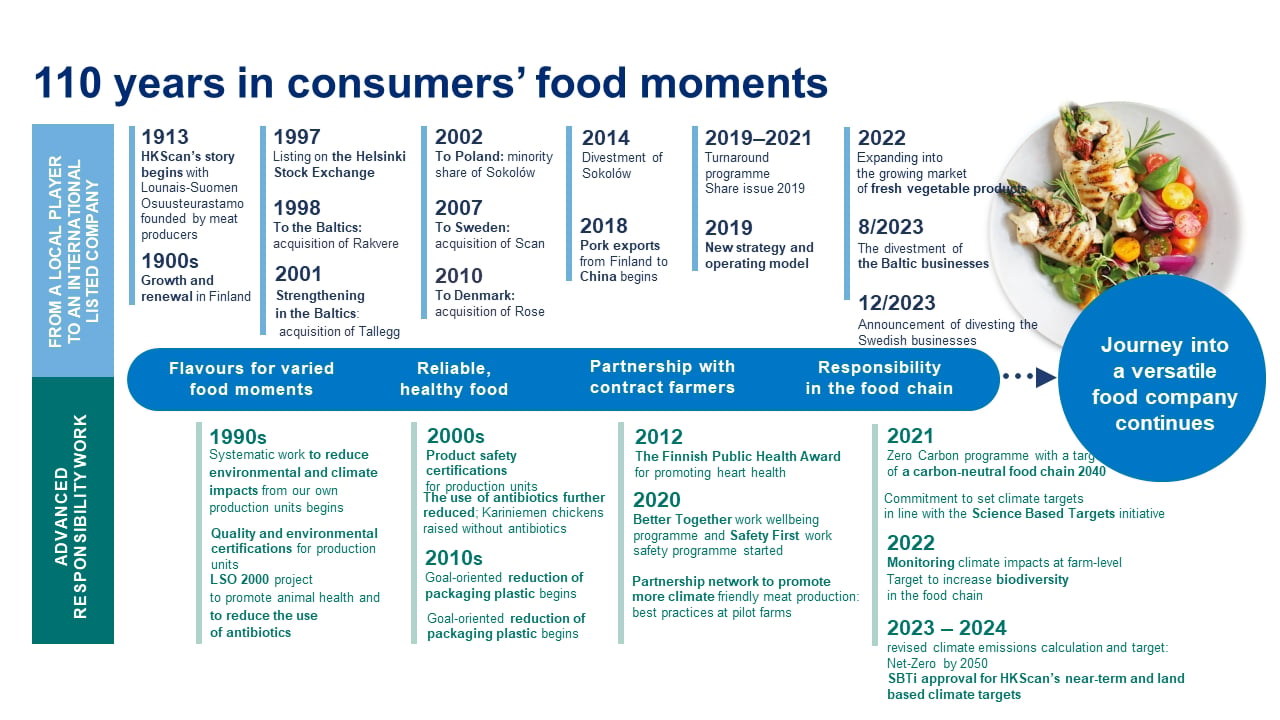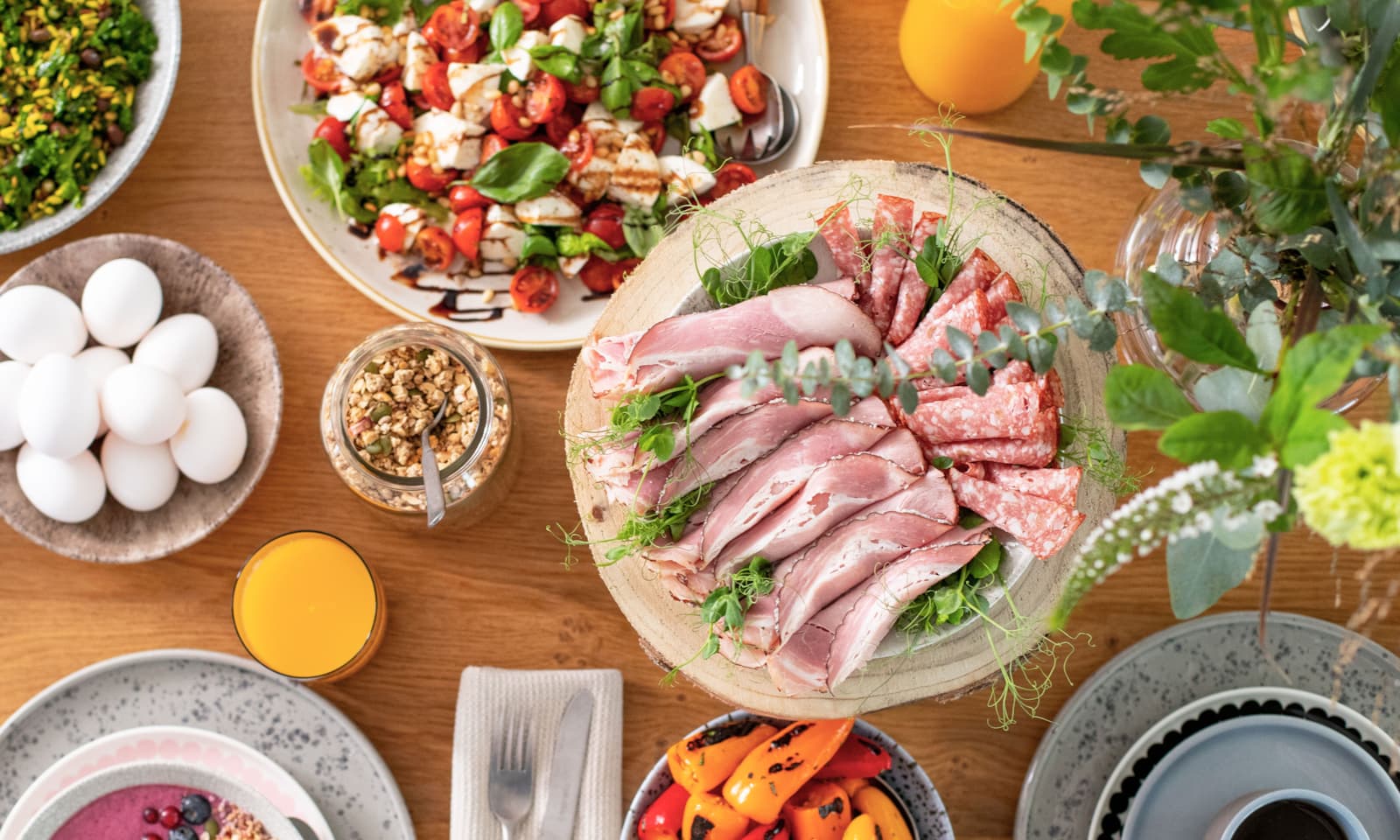HKScan's journey into an international listed company started in January 1913, when about twenty farmers from the south-west of Finland founded Lounais-Suomen Osuusteurastamo.
110 Meaty Years
|
|
Read more about anniversary documentary
2019
New strategy, Turnaround programme and partnerships

The new strategy focuses on the Turnaround programme for 2019-2021 to improve the company's profitability and on creating a strong foundation for the company’s future growth. HKScan aims to grow profitably into a versatile food company and to strengthen its market position in evolving markets together with its customers.
Strong partnerships are part of the strategy and create the basis for achieving the targets. In addition, the company’s goal-oriented responsibility work will be more strongly integrated into the basis of the business and consumer brands.
2018
Exports to China started
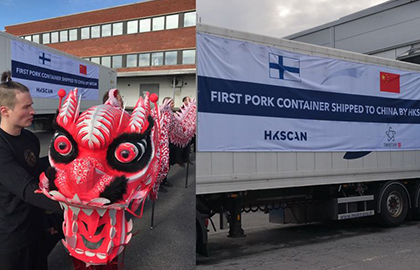
Pork exports from Finland to China started from the Forssa unit in April 2018. The first container was shipped on 23 April 2018. The destination of the 25,000 kg consignment shipped by sea was Tianjin Port in China.
2017
Rauma poultry unit completed
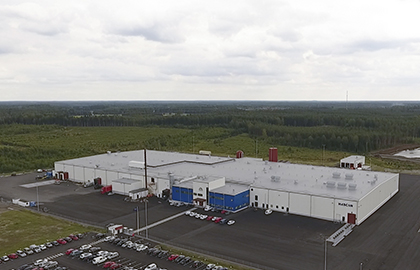
Poultry consumption continues to grow in Finland. At the end of 2017, the Rauma poultry unit, announced two years earlier, was completed in Finland, replacing the production plant in Eura.
The location of the unit in Rauma is central, as Kariniemen chickens grow on HKScan’s contract farms in Satakunta and Southwest Finland. Thanks to our own contract farming, poultry meat used in Kariniemen products is 100% Finnish.
2015
HKScan acquired a 50% stake in Paimion Teurastamo, a cattle slaughterhouse
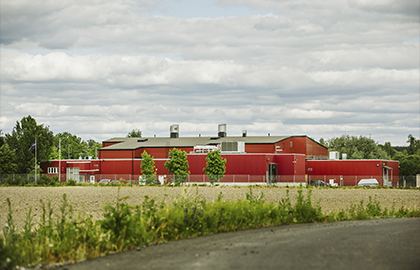
Paimion Teurastamo operates in premises taken into use in 2012. HKScan also has another cattle slaughterhouse in Outokumpu. The model of two cattle slaughterhouses allows for the shortest possible distances for animal transport and offers contract farmers speed and flexibility for animal pick up.
2014
HKScan divested its ownership of Sokolóv by selling its stake in Saturn Nordic Holding AB
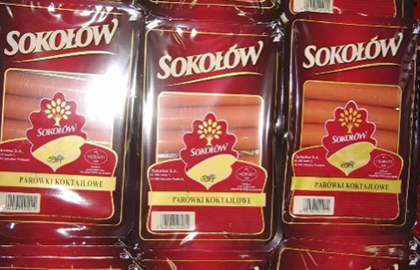
HKcan sold its 50% shareholding in Saturn Nordic Holding AB to Danish Crown A/S, the other owner of the company, thus ending HKScan's indirect ownership in its Polish joint venture Sokolów.
2013
The food industry expert turns 100
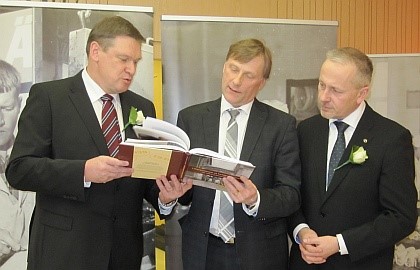
HKScan turned one hundred years old on 11 January 2013. Precisely a hundred years earlier, about twenty livestock farmers from the south-west of Finland signed the documents that established a provincial slaughterhouse company. Over one hundred years, the company has grown into the present-day international food company HKScan, one of Northern Europe's leading food industry experts.
HKScan and its largest owner, LSO Osuuskunta – composed of meat producers, share a history and therefore also this centennial.
The history book, released on the 100th anniversary, is studied by Hannu Kottonen, HKScan's CEO (on the left), Jari Koskinen, Minister of Agriculture and Forestry, who opened the festive year, and Veikko Kemppi, CEO of LSO Osuuskunta.
Read more:
2011
HK Rypsiporsas®
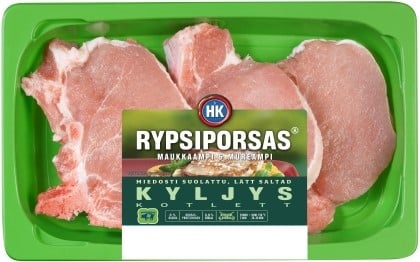
HK Rypsiporsas® was HK Ruokatalo's most notable product launch in 2011. It is a new kind of pork meat, in which special attention has been paid to the natural composition of fat.
The research and development phase, which spanned several years, investigated the effect that changes in pigs' diets have on the composition of fat in pork meat. Adding the right proportion of rapeseed oil to the feed had the desired effect, and proved successful in lowering the proportion of saturated (hard) fat in the meat to recommended nutritional levels.
Substituting some of the saturated fat for unsaturated (soft) fat in HK Rypsiporsas® products was an important innovation for both HK Ruokatalo's meat producers, as well as for the public health in Finland.
The nutritional strategy drawn up in HK Ruokatalo in 2007 created a unified process for reducing the amount of saturated fat and salt – equally important in terms of public health – in the company's products. Our product development also faced expectations of increasingly accurate analyses on the use of additives.
Our achievements on this front earned us the National Institute for Health and Welfare's annual national health recognition award in 2012. This recognition was based on the significant reduction of salt and saturated fat in our products.
2010
Arriving on Danish soil
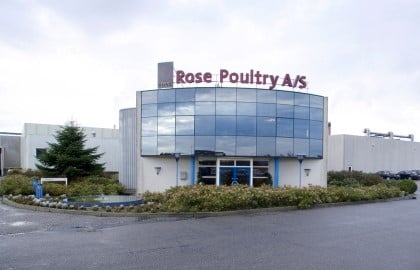
When its owners consisting of three Danish family enterprises offered to sell their company to HKScan, in the autumn of 2011, Rose Poultry A/S was the biggest company in the Danish poultry industry.
In addition to its three production facilities in Denmark, the company's Rose brand was known not only there, but also in export markets in the Middle East and South-East Asia.
From a strategic point of view, the corporate acquisition was an excellent addition to HKScan's corporate community, and the fact that Rose Poultry's home market includes Sweden in addition to Denmark was a further advantage, since HKScan Group had no previous presence in the Swedish poultry market.
2007
Expansion to Sweden
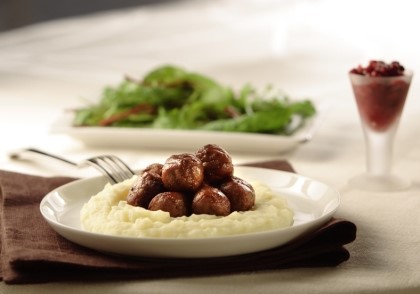
Swedish meat producers were looking for an international partner which could join their efforts to develop the future of Swedish meat production. After weighing the available options, they decided to sell the Swedish Meats business to HK Ruokatalo Group in the autumn of 2006.
The deal was sealed in January 2007 in such a way that the industrial and marketing segments were combined to form the limited liability company Scan AB, the shares of which were then bought by HK Ruokatalo Group. Scan was by far the largest company in the Swedish meat industry. HK Ruokatalo Group's net sales nearly doubled as a result of the corporate acquisition.
That same year, the robust of expansion of the Group's international business gave reason to change the Group's name from HK Ruokatalo Group to HKScan.
2003
Arrangements on the domestic front
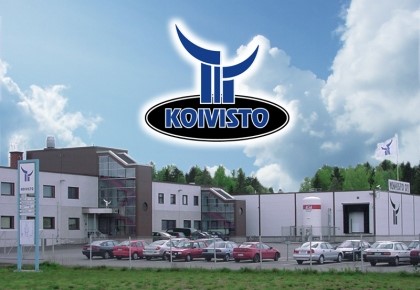
HK Ruokatalo was active not only in the international marketplace, but the domestic one. In 2003, it made several corporate acquisitions the aim of which was the further promotion of the production and sales of Finnish meat.
The outcome of one of these acquisitions was that the Mellilä-based Koiviston Teurastamo Oy became a subsidiary of HK Ruokatalo. That same year, the Group also acquired an interest in Lihatukku Harri Tamminen Oy, a company located in Vantaa. In addition, the Outokumpu-based Pouttu Foods Oy, a joint venture the Group had been involved in since 1997, transferred to the full ownership of HK Ruokatalo.
The production facilities in Mellilä (pictured) had been thoroughly renewed a couple of years before the owners sold them to HK Ruokatalo.
2002
Poland becomes a country of interest
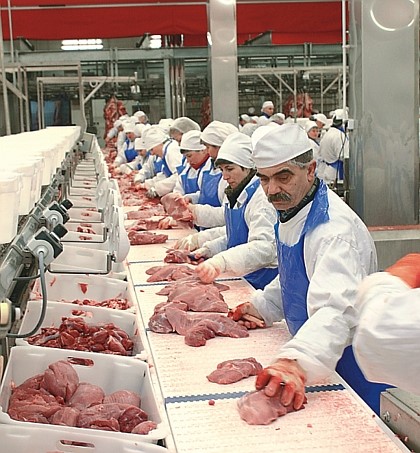
Having expanded into the Baltic countries during the latter half of the 1990s, HK Ruokatalo set its sights further south, on Central Europe. In December 2002, the Group was provided with an opportunity to acquire a minority share in Poland's second largest meat company, Sokolów.
Following its initial eleven -per cent stake in the company, HK Ruokatalo first increased its ownership on its own, and later together with the Danish meat conglomerate Danish Crown. By 2006, Sokolów was entirely under Finnish-Danish ownership, and was pulled from the Warsaw Stock Exchange.
Sokolów was a product of the large-scale structural reorganisations that the Polish meat industry underwent in the 1990s, when the country's oldest and most prestigious companies were combined into enterprises that could meet EU criteria. In a fragmented sector, it was also the only one with a sales network that covered the entire country.
Saturn Nordic Holding AB, which is charged with the ownership of Sokolów's shares, was established in 2004 for the purposes of the Finnish-Danish ownership.
2001
Poultry house Tallegg
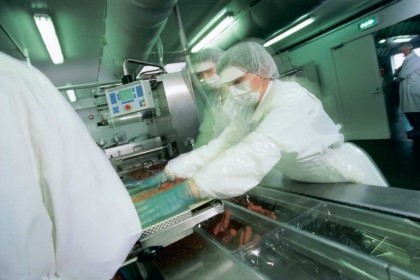
In the summer of 2001, HK Ruokatalo and the Swedish Farmers' Association LFR joined forces to acquire majority ownership of AS Tallegg. At the time, Tallegg was already Estonia's largest producer of poultry meat and eggs, with several facilities in the vicinity of Tallinn and subsidiaries in Latvia and Lithuania.
Tallegg's production was integrated up to a point where it managed the entire production chain from feed preparation and chick production to raising broilers and the further processing and marketing of products. It was, in effect, the only Estonian producer able to deliver locally grown poultry, whereas other producers were largely dependent on imported raw materials.
LFR has since changed its strategy in terms of foreign ownership, and sold its own half of Tallegg to HK Ruokatalo in December 2003.
1998
Internationalisation begins at Rakvere
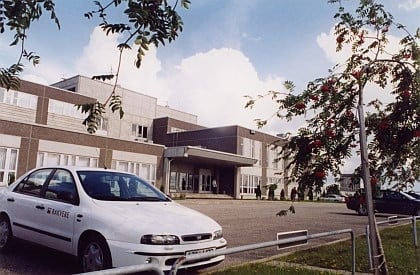
To ensure growth during the coming years the Group, in December 1998, made a strategic decision to begin expanding beyond Finnish borders. The objective was to seek out companies that were market leaders in the meat industry in their respective countries and/or companies with leading product brands.
The first step was the acquisition of the largest meat producer in Estonia and the Baltic countries as whole, AS Rakvere Lihakombinaatti, in the summer of 1998. The production facility at Rakvere was modern, having been designed and built by Finns some eight or nine years earlier. Originally, the plant was designed to produce food-stuffs not only for Estonia and the other Baltic countries, but also the economic area of Leningrad.
The acquisition of Rakvere Lihakombinaatti included its Latvian subsidiary A/S Rigas Miesniks, in turn a leading company in the Latvian meat industry.
The degree of Rakvere's self-sufficiency in terms of raw materials within Estonia was also notable and a point of interest: it owned AS Ekseko, a piggery company with industrial-scale pork meat operations in Central Estonia.
1993
New growth through Kariniemi
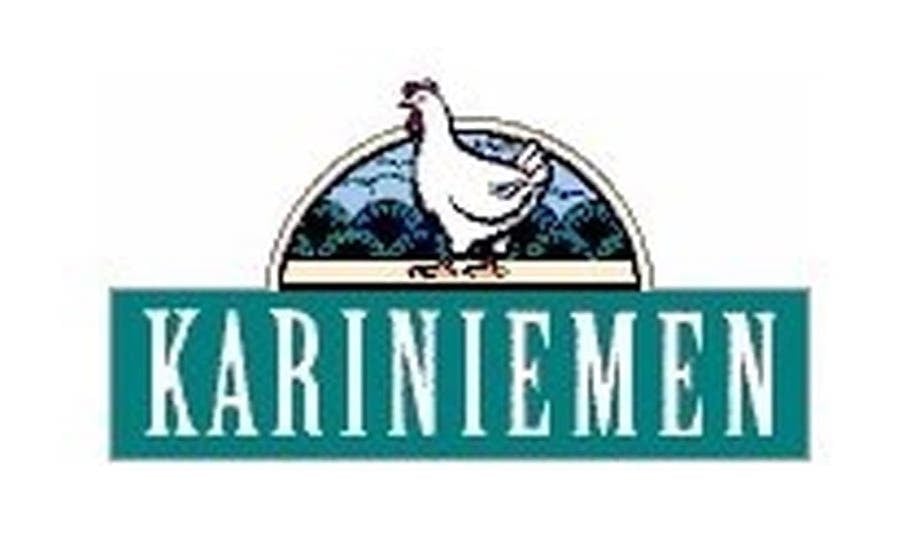
The Finnish poultry industry was faced with a turning point in March 1993 when LSO bought the poultry business of Kariniemi Oy (then a part of Cultor corporation), and combined it with its own Broilertalo. The result was a market leader of a kind the industry, suffering from overcapacity, had been in need of.
As part of this change, Broilertalo centralised the slaughter and jointing of chicken to Eura, and the production of pre-cooked products to Säkylä. Some years later it also adopted the Kariniemi brand for all its products, being aware of that brand's good reputation among consumers.
The acquisition of Kariniemi provided the company with an important agent for growth, one whose potency lasted for several years. The poultry business of HK Ruokatalo made good profits even when times were tougher for other meat products.
The honey-marinated chicken of Kariniemi, launched in 1992, became a hit product for the Group. The easy-to-use sliced and marinated chicken fillets changed the eating habits of Finnish families from the early 1990s onwards, bringing a new convenient alternative to the traditional minced beef or pork to kitchens around the country.
Broilertalo Oy continued operations as one of the Group companies until 2005, when it merged with HK Ruokatalo Oy's business.
1991
Ruokatalo comes to Vantaa
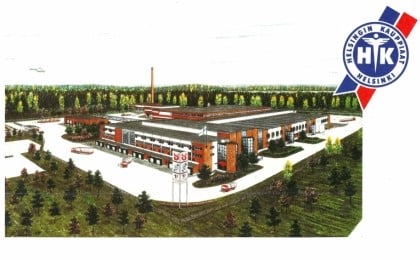
The production facility of Helsingin Kauppiaat, located in the district of Pakkala in Vantaa, was extended and modernised over a two-year period from 1989 to 1991. The project's scale was exceptional, but HK's facilities in Sörnäinen (Helsinki) were hopelessly outdated and the company required modern-day production capacity for future needs.
But when the project's completion was celebrated in the summer of 1991, the keynote speech was given by the chairman of LSO's Board of Directors. This was because the plant's owner had just changed; when the cooperative slaughterhouses decided to dissolve their central firm in March 1991, the Vantaa plant had been transferred to LSO.
The meat industry's major restructuring begins
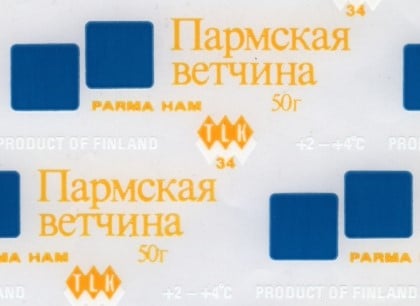
In March 1991, the largest cooperative slaughterhouses – LSO included – decided to dissolve their central firm, Tuottajain Lihakeskuskunta. This decision represented the most significant change in the producer-owned meat industry in decades. It was based on the firm's long-standing internal debate about the direction of operational development.
The dissolution was carried out by incorporating the central firm's industrial and marketing segments into Helsingin Kauppiaat Oy, after which LSO bought Helsingin Kauppiaat and its HK brand, as well as the production facility in Vantaa. Primary production services were relocated to the Finnish Meat Research Institute in Hämeenlinna, whereas the rest of the central firm's operations were discontinued.
The 1991 upheaval in the meat industry ended the old era before the new one had even arrived on the drawing boards. At LSO, the process of adjusting operations to the transformation took years and necessitated intense – even partly dramatic – restructuring measures and shutdowns of production facilities before the company's profitability and competitiveness were secured.
1989
SOT's merger with LSO
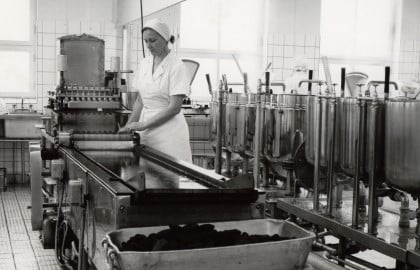
The last traditional merger carried out between provincial cooperative slaughterhouses: SOT, or Satahämeen Osuusteurastamo, merged with LSO Osuuskunta at the beginning of 1989. The production facilities in Pori continued to operate for some years after the merger, and those in Tampere until 2008.
As a result of the merger, LSO had some 25,000 members at the beginning of 1989, which was more than ever before or since.
(Picture) Meatballs being prepared on the convenience food line at SOT's Pori plant in the 1970s.
1988
The beginnings of HKScan
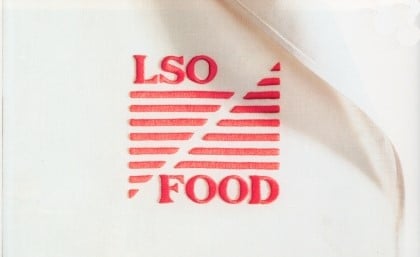
HKScan's present-day form saw its beginnings in the summer of 1988, when LSO, or Lounais-Suomen Osuusteurastamo, incorporated its industrial and marketing segments. The company had production facilities in Turku, Forssa, Salo, Lahti and Kerava, a sales office and shipping department in Helsinki, as well as subsidiaries in Säkylä and Ekenäs (Tammisaari). Pori and Tampere joined in the following year, Vantaa and Riihimäki in 1991, Eura and Köyliö in 1993 and Outokumpu in 1997. Since the new millennium, the company has gained new members from Mellilä and Mikkeli, among other locales.
The company's original name, LSO Food Oy, was changed to the more consumer-friendly HK Ruokatalo in January 1997, and to HKScan Corporation in April 2007, when the international side of the business saw rapid and significant expansion.
The company was listed on the Helsinki Stock Exchange in 1997 and began its internationalisation a year later. So far, this process has resulted in a more than five-fold increase in the Group's net sales, and more than tripled the number of its personnel.
1985
S Group withdraws from the meat industry
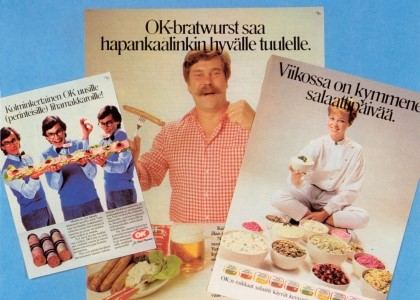
In October 1985, the cooperative shops of SOK sold OK-Liha, which had been in their ownership until then, to Tuottajain Lihakeskuskunta and the cooperative slaughterhouses which, in turn, bought OK-Liha's plants in their respective regions around Finland.
As a part of this process, LSO acquired the sausage factory in Riihimäki as well as a somewhat old plant in Teräsrautela, Turku. As a result of the deal, the cooperative slaughterhouses also acquired the OK brand.
1983
Broilertalo's Säkylä plant opens for production
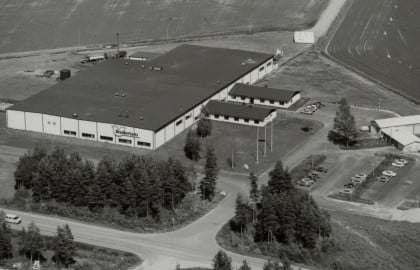
The new production facility of the largest poultry slaughterhouse in the Nordic countries, Broilertalo Oy, located in Säkylä, was completed in 1983. Broilertalo continued the legacy that LSO had begun with its chicken breeders as far back as at the beginning of the 1960s, when this "American delicacy" was only just arriving on our shores.
When the Säkylä plant began operations, the majority of chicken was sold whole and frozen. The plant's ambitious goal was to start building a high-quality cold chain good enough to get Finnish consumers accustomed to fresh produce. It was successful too.
Broilertalo became the biggest poultry slaughterhouse in 1993, when it acquired its Eura-based competitor, Kariniemi. As an outcome of the deal, Broilertalo's head office relocated to Eura, which also became the central location for slaughtering and cutting. Säkylä functioned as the production facility of pre-cooked poultry products until 2012.
Broilertalo's Säkylä plant (pictured) in 1984.
1981
OTK sells its meat business
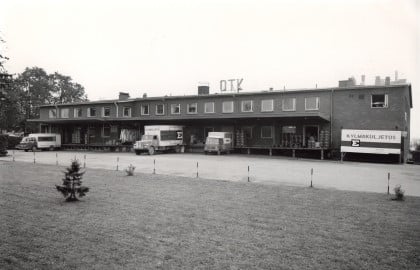
In October 1981, Työväen osuuskauppaliike OTK began a restructuring of its operations, and in this context disposed of its meat business, which was bought by Tuottajain Lihakeskuskunta and the cooperative slaughterhouses.
As a result of a further transaction, LSO took charge of OTK's slaughterhouse in Vantaa and the convenience food plants at Hippos in Turku and in Lahti. The production resources of Helsingin Kauppiaat gained a significant addition in the form of OTK's convenience food plant in Vantaa. The transaction also covered the Serve and Winner brands.
(Picture) OTK's Lahti production facility in 1975.
1977
Retail shops
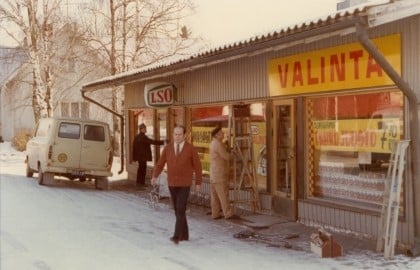
LSO decided to abandon its network of retail shops, which it had run since 1915. At its height in 1952, the network included 74 operational retail shops.
In 1974, the remaining shops formed Ruokakeidas Oy, which was sold to the central firm Tuko three years later.
(Picture) LSO's shop at Vista, Paimio, during the early 1970s.
1976
HK Kabanossi® and the new age of barbecue
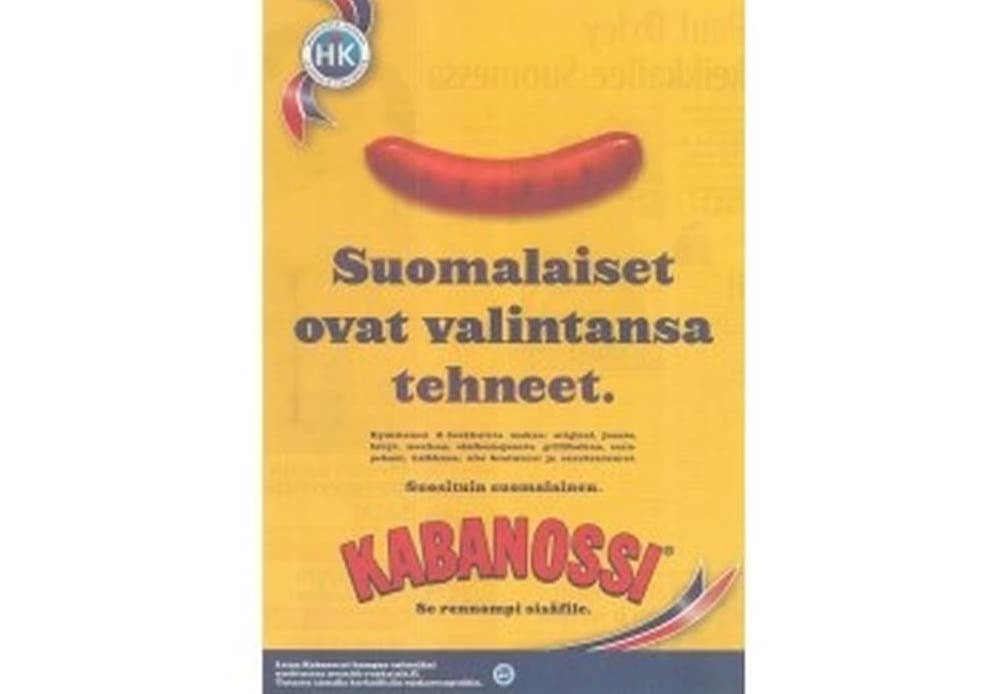
In spring 1976, Helsingin Kauppiaat introduced a new sausage called HK Kabanossi®, which became a household name in Finland in a few years.
The sausage was influenced by the cuisine of Central Europe, especially Austria and Hungary, where cabanossi sausages are popular. They are usually of the salami type there, whereas the goal in Finland was particularly to create a barbecue sausage. Summer barbecuing was extensively gaining ground in Finland in the 1970s. However, the heat of the barbecue involves specific requirements for manufacturers, in regard to the structure of the sausage and the intestinal material used as the casing. This development resulted in the Finnish version – HK Kabanossi®
This ad is from the 1990s.
1975
Forssa becomes a centre for slaughterhouses
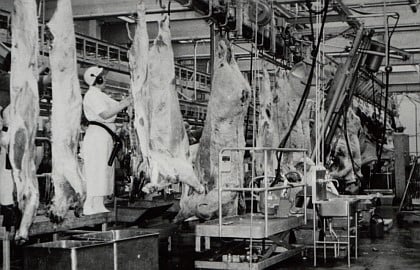
Forssa became the centre of LSO's slaughtering operations in the spring of 1975. The industrial-scale slaughterhouse completed in the Talsila industrial estate at the time has spearheaded the development and centralisation of LSO and HK Ruokatalo's slaughterhouse operations for decades.
The maintenance of productivity by means of continuous investment in productive activities has been a focus from the very beginning. In addition, the facility has undergone large-scale expansion and modernisation every ten years or so. Due to such efforts, over the years it has been able to assume responsibility alternately for the kilos produced by LSO's slaughterhouses in Turku, Tampere, Pori and Salo.
As of 2000, the facility in Forssa has focused exclusively on the slaughtering and cutting of pork; this was the year when beef slaughtering was moved elsewhere.
1971
The market in southern Finland gains clarity
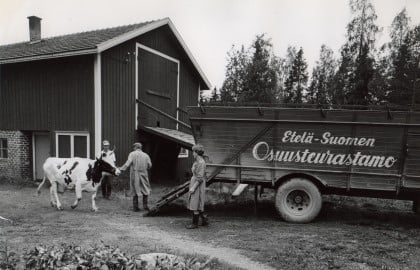
The cooperative livestock trade gained some clarity in March 1971, when Etelä-Suomen Osuusteurastamo (ESO) merged with LSO. ESO had some 3,600 producer members, and operated in the regions of Kerava, Lahti and Hämeenlinna. Following the merger, LSO's operating range covered all of the most densely populated areas of southern and south-western Finland.
(Picture) ESO's cattle truck making its rounds in the 1960s.
1968
The introduction of Popsi sausages
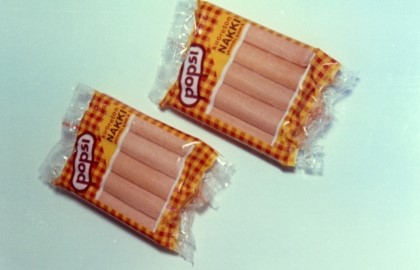
In the autumn of 1968, LSO adopted a new umbrella name, Popsi, for its products. The first meat products to carry the name were Popsi-lenkki and Popsi-nakki. A year later, these were followed by Popsi kuoreton nakki and Popsi-grillilenkki. The casingless Popsi sausages (Popsi kuoreton nakki) proved to be particularly popular products.
This picture from 1970 shows casingless Popsi sausages in a vacuum pack.
1964
The operating area expands for the first time
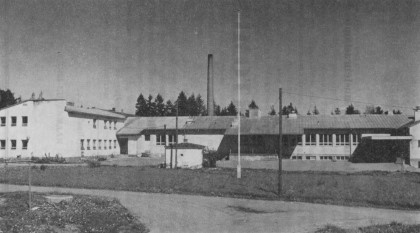
For the first time since its establishment in 1913, LSO expanded its operating range by merging with its neighbour, Länsi-Uudenmaan Osuusteurastamo (LUO), in 1964. LUO's producers had thinned down to approximately 2,200 members. Its operating areas, now merged into those of LSO, covered the regions of Karjaa and Hanko.
This picture from the early 1960s shows LUO's Lohja production facility.
1963
HK Sininen Lenkki® enters the market
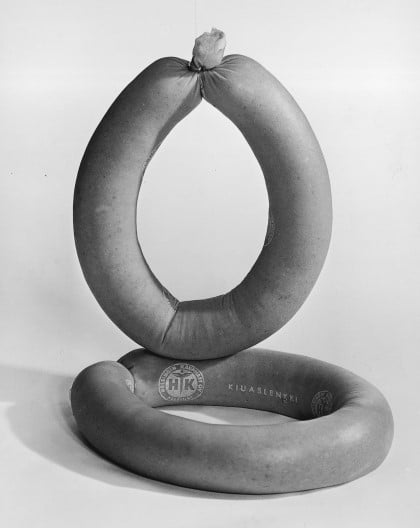
When Helsingin Kauppiaat's new ring-shaped bologna sausage hit the market in 1963, it had everything going for it: good flavour, an agreeable texture and the right seasoning. The new sausage was encased in a synthetic Naturin skin, a novelty at the time. And to add to the product's distinction, the skin had the following word printed on it in blue: Lenkkimakkara.
Thanks to the blue lettering, customers gradually began to order this particular sausage as "HK's blue", due to which the sausage was eventually also given the official name HK Sininen Lenkki® ("HK's Blue Ring"). The brand was registered in 1980.
HK Sininen Lenkki® has been packed in a vacuum pack since 1973. At that time, the blue text was also moved from the sausage's skin to the pack.
The consumption of sausages in Finland grew throughout the 1970s and 1980s, and during these two decades HK Sininen Lenkki came to be the highest selling bologna ring in Finland and the Nordic countries. In many years its production has surpassed the 10 million kilo mark. Even today, it is one of HK Ruokatalo's biggest individual products.
The ring is still made nearly according to the original recipe, although the amount of fat and salt has been adjusted in step with changes in lifestyles and nutritional recommendations. In addition, the product range has been supplemented with a light version and other alternatives.
Along with HK Kiuaslenkki (pictured), the shape of HK Sininen Lenkki® used to be round in the 1960s.
1958
Free up homemakers' time
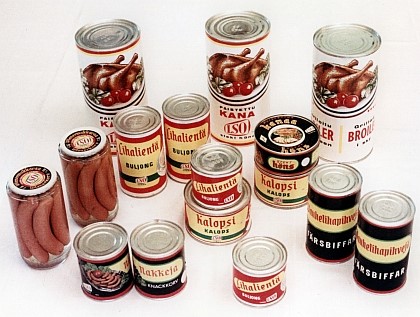
"Why burden the wife during summertime, when everyone else can enjoy their holidays?" was the question asked in LSO's print ad dating back to 1958. Tinned food was a big relief and always a welcome help in the times before refrigerators started to become more commonplace in homes, in the latter half of the 1950s.
LSO had been manufacturing tinned food since 1937, and production had always been characterised by significant seasonal variation. The plant was able to produce the volume consumed throughout an entire year in a matter of months. Indeed, continuous production relied heavily on orders from the Finnish Defence Forces', which provided the required base volume. In the 1980s, LSO also produced tinned food for development aid projects.
LSO's tinned food factory in Turku produced its last batches of tinned food in 1994. They consisted of tinned meat and had been ordered as provisions for Finnish UN peacekeeping troops.
(Picture) A display of tinned food from the early 1960s. The range of food packed into tin cans and glass jars included meat patties, chicken, stock, grilled chicken, pot roast and even frankfurters.
1949
The beginnings of Helsingin Kauppiaat
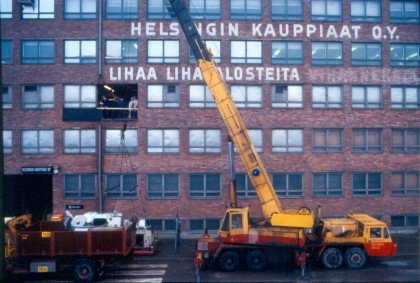
During its early days, the company, founded by businessman Erkki Salonoja, supplied meat, fish and vegetables in the capital city. A couple of years later it started the production of its own sausages, and in 1955 relocated to the industrial quarters in Sörnäinen, Helsinki. These were the first steps on HK's journey to becoming the biggest sausage plant in the Nordic countries.
In 1959, Kesko joined Salonoja as another owner of HK. The owners developed and expanded HK's operations until 1975, at which point they sold the company's entire share capital to Tuottajain Lihakeskuskunta.
(Picture) Vanha talvitie 3 in Sörnäinen. This small-industrial property completed in 1956 was where Erkki Salonoja bought the first floor for HK's use. When it soon became obvious that more space was required, Salonoja continued to buy more space one floor at a time. HK let go of the premises in 1991, when a large part of the company's operations had moved to Pakkala, Vantaa.
1938
The golden age of exports
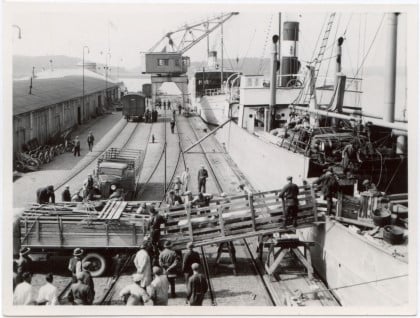
LSO's new bacon slaughterhouse in Turku was completed in the early 1930s. This new facility enabled an increase in production and the start of a profitable exports business. LSO grew to become Finland's largest exporter of meat which, during its best years, exported millions of kilos of bacon to England and pork to Sweden. At the end of that same decade, it also exported beef to Central Europe.
This picture was taken at the Port of Turku in the spring of 1938 and shows live pigs being taken aboard for shipment to Germany. Live pigs could be shipped only in the spring or autumn, when the weather was cool enough. LSO continued to ship pigs for another two years before the war interrupted trade.
1936
The central firm TLK is born
In 1936, the cooperative slaughterhouses established Tuottajain Lihakeskuskunta as their central firm after having first separated from Karjakeskuskunta, managed by cooperative shops. LSO had been a strong advocate for the establishment of an independent organisation. This marked the beginning of a 50-year dispute called the "the great cattle dispute" (Suuri karjariita) between the two central firms. What was fundamentally at stake was to which camp – the cooperative slaughterhouses or the cooperative shops – farmers sold their livestock. Both camps were of the opinion that they better represented in the interests of the rural population.
1921
Motor vehicles arrive on the scene
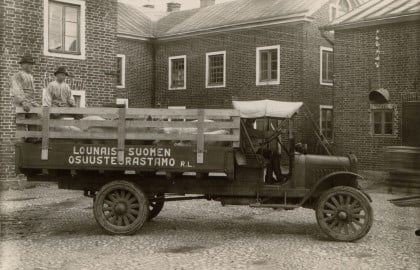
After lengthy considerations in 1921, the company's board of managers decided to procure the company's first truck. The Republic had a canvas top and solid-rubber tyres. (Picture) The Republic parked in front of the former sausage plant in Turku. The truck was used for transporting livestock from as far away as Vehmaa and Laitila.
1913
A hundred years ago
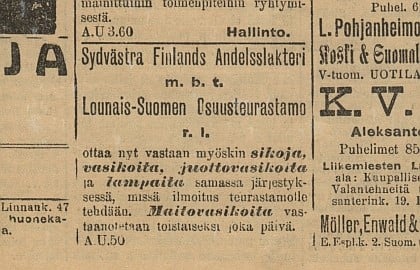
About twenty livestock farmers from the south-west of Finland founded Lounais-Suomen Osuusteurastamo on 11 January 1913. The cooperative was charged with the task of gathering the animals raised by its members, slaughtering them and selling the meat. A couple of years later, the tasks came to include the production of sausages.
During the early days, many members were Swedish-speaking folk, the proprietors of big farms with more stock to sell, and who therefore were also interested in putting things right when it came to organising the sale of livestock. In a matter of years, however, Finnish-speaking farmers came to form a majority among the members.
(Picture) This newspaper ad from 1914 advertises LSO's willingness to buy livestock of every kind.

